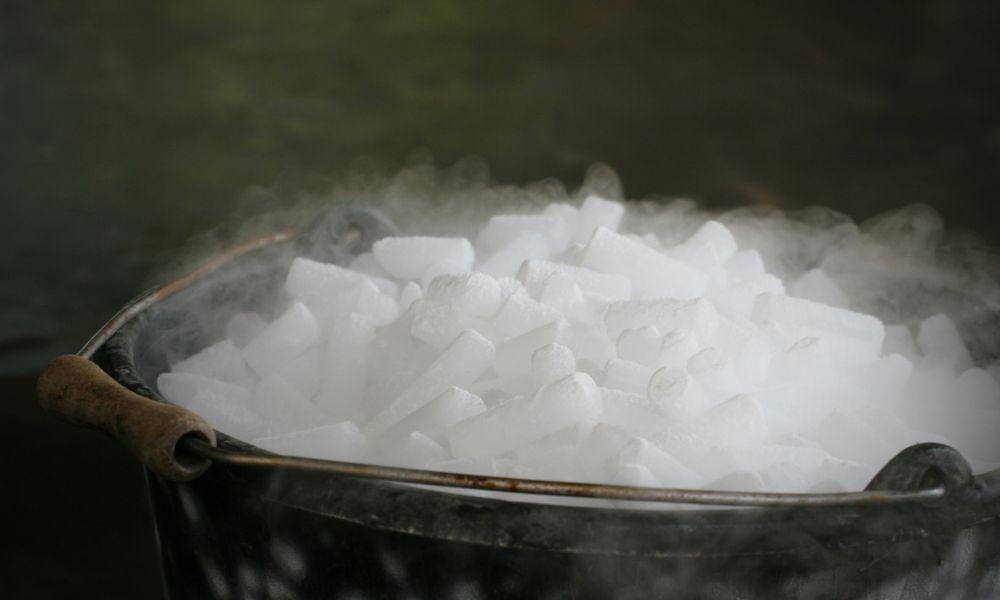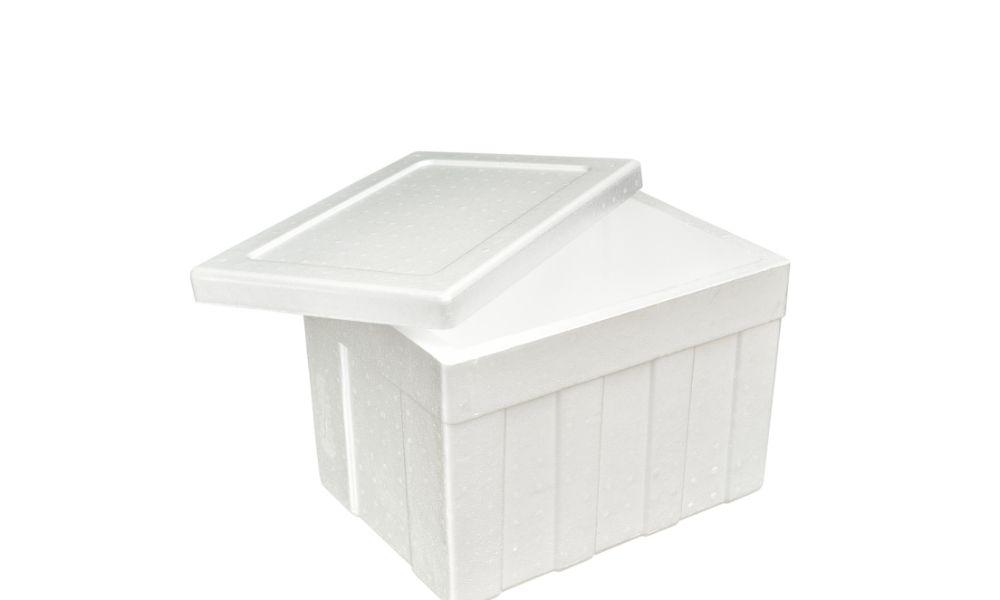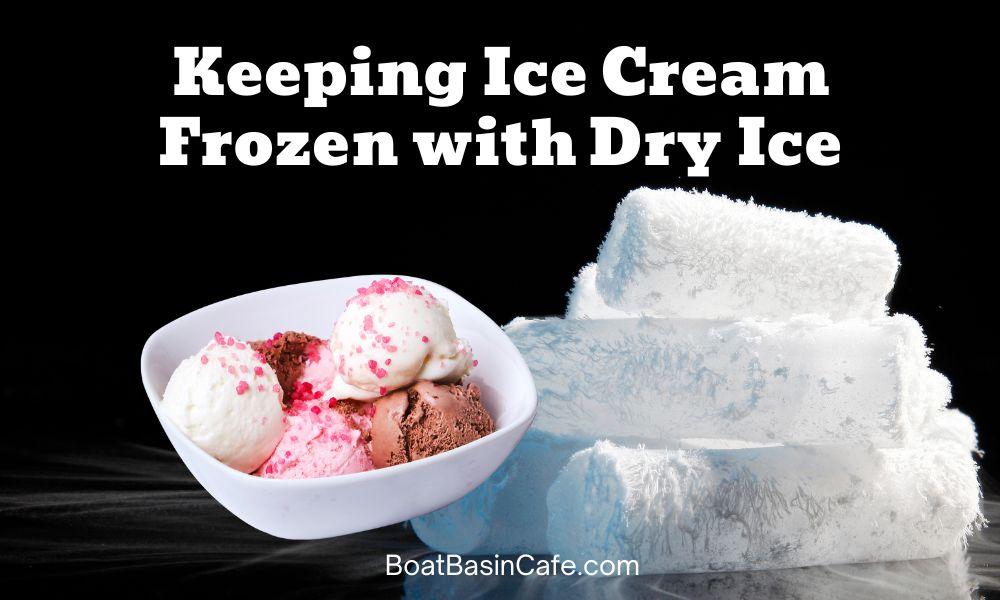Who doesn’t enjoy ice cream? But have you ever had to throw out a tub of melted ice cream because you couldn’t keep it frozen? Worry no longer! Dry ice may be the answer to keeping your favorite dessert frozen for longer in hot day. But how exactly does it work, and what precautions should you take when using it?
Dry ice is the solid form of carbon dioxide, and it can keep your ice cream frozen for longer than regular ice. However, using it requires caution because it can be dangerous if not handled properly.
In this article, we’ll go over everything you need to know how dry ice can help ice cream stay frozen for longer periods, including the science behind how it works, the precautions you should take when handling it, and the best practices for using it. We consulted with experts in the field to bring you the most reliable and trustworthy information.
So, if you’re an ice cream lover looking for ways to keep your favorite treat frozen, keep reading to learn everything you need to know about using dry ice!
What is dry ice?

Dry ice is a solid form of carbon dioxide (CO2) that is used as a refrigerant to keep items, including ice cream, frozen during transportation and storage. It is called “dry ice” because it doesn’t melt into a liquid form like regular ice but rather sublimates directly into a gas.
How is it Made?
The intricacies surrounding the production of dry ice are rooted in the compressive process of carbon dioxide gas. Through the act of compression, this gas is subjected to an environmental temperature that plummets to a frigid -109.3°F (-78.5°C).
It is at this point that the carbon dioxide undergoes a direct metamorphosis from a gaseous state into a solid state, bypassing any transitional liquid stage. The resulting byproduct of this transformation is commonly known as dry ice. In its fully formed state, dry ice takes on various physical configurations ranging from the malleable block shape to the more diminutive pellet and flake formats.
These different shapes are implemented in accordance with the specific context in which the dry ice will be utilized.
Understanding the Safety Precautions for Handling Dry Ice
Dry ice is a useful refrigerant due to its extremely cold temperature. With a surface temperature of -109.3°F (-78.5°C), dry ice is much colder than regular ice, which has a temperature of 32°F (0°C). When dry ice is used to keep items frozen, it can do so for a longer period of time.
Additionally, when dry ice is combined with rock salt, it creates a reaction that causes the dry ice to expand, which can be useful for certain applications.
However, there are some safety precautions that need to be taken when handling dry ice. Direct contact with dry ice can cause severe burns or frostbite, so it’s crucial to use protective equipment such as gloves or tongs.
Additionally, dry ice should never be stored in airtight containers, as the pressure buildup can cause the container to explode. Dry ice should also not be placed in a refrigerator or freezer, as the extremely cold temperature can cause the appliance to malfunction.
Here are some safety precautions to keep in mind when handling dry ice:
- Wear protective gloves: Dry ice can cause frostbite if it comes into direct contact with the skin. Always wear protective gloves when handling dry ice to prevent injury.
- Use eye protection: When handling dry ice, small pieces can fly into the air and cause eye injuries. Wear eye protection to keep your eyes safe.
- Store in a well-ventilated area: Dry ice releases carbon dioxide gas as it melts, which can displace oxygen in enclosed spaces. Always store dry ice in a well-ventilated area to prevent the buildup of gas.
- Do not touch with bare hands: As mentioned above, dry ice can cause frostbite if it comes into contact with skin. Do not touch dry ice with bare hands.
- Do not store in an airtight container: As dry ice melts, it releases carbon dioxide gas, which can build up pressure in an airtight container and cause it to explode. Always store dry ice in a container with a vent or leave the lid slightly open.
- Use in a well-lit area: Dry ice can create a fog-like effect when it is exposed to warm air. Use dry ice in a well-lit area to prevent tripping or other accidents.
Dry ice is an effective refrigerant that doesn’t ice cream and is commonly used in the storage and transportation of perishable goods.
However, it’s crucial to follow safety precautions such as wearing protective gloves, storing it in a well-ventilated area, and avoiding airtight containers, as cold air sinks and carbon dioxide gas can be hazardous.
Will dry ice keep ice cream frozen?

Dry ice can keep ice cream frozen because of the unique properties of carbon dioxide in its solid state. When dry ice is placed in contact with ice cream, it sublimates from a solid to a gas, releasing carbon dioxide.
This process causes the temperature of the dry ice to drop, creating a cold environment that can freeze the ice cream and maintain its frozen state.
Dry Ice vs. Regular Ice
| Property | Dry Ice | Regular Ice |
|---|---|---|
| Temperature | Approximately -78.5°C (-109.3°F) | 0°C (32°F) |
| Duration of Freezing | Lasts longer, as it sublimates slowly | Melts faster |
| Handling | Requires protective gloves due to extreme cold temperature and potential for skin damage | Safe to handle with bare hands |
| Cooling Efficiency | Cools items much faster than regular ice | Cools items slowly |
| Cost | More expensive than regular ice | Less expensive than dry ice |
| Carbon Dioxide Emissions | Emits carbon dioxide as it sublimates | No carbon dioxide emissions |
| Ability to keep ice cream frozen | Creates a much colder environment than regular ice, making it more effective at keeping ice cream frozen for extended periods. Takes up less space than regular ice, which is an important factor when transporting ice cream in bulk. | Not as effective as dry ice at keeping ice cream frozen for extended periods. Takes up more space than dry ice. |
| Effectiveness and Efficiency | Dry ice is more effective and efficient than traditional ice because it is much colder and can keep ice cream frozen for longer periods of time. It also takes up less space, which can help reduce shipping costs and make transportation more efficient, especially for long-distance trips. | Regular ice is less effective and efficient than dry ice for keeping ice cream frozen for extended periods, and takes up more space. |
Best Practices: How to use dry ice to keep ice cream frozen?

01 How much dry ice do I need for ice cream
The amount of dry ice needed will depend on the quantity of ice cream being transported or stored, as well as the size of the container being used.
A general rule of thumb is to use 5 to 10 pounds of dry ice for every 24 hours of ice cream storage or transportation.
To calculate the amount of dry ice needed for a certain quantity of ice cream, you will need to know the weight of the ice cream and the amount of time it needs to remain frozen. Here is a general formula to calculate the amount of dry ice needed:
Amount of dry ice (in pounds) = (Weight of ice cream in pounds) x (Duration of storage in hours) x (Insulation factor)
The insulation factor will vary depending on the type of container used to store the ice cream. As a general guideline, use the following insulation factors:
- Styrofoam coolers: 0.5
- Cardboard boxes: 0.3
- Plastic coolers: 0.8
For example, let’s say you have 10 pounds of ice cream that needs to be stored for 6 hours in a styrofoam cooler. Using the formula above, the amount of dry ice needed would be:
Amount of dry ice = 10 x 6 x 0.5 = 30 pounds
Therefore, you would need 30 pounds of dry ice to keep 10 pounds of ice cream frozen for 6 hours in a styrofoam cooler.
02 Purchase and handle the dry ice safely
When purchasing dry ice, it is important to wear gloves and use tongs to handle it, as it can cause frostbite and skin damage. Dry ice should be stored in a well-ventilated area, such as a cooler or insulated box, and never in a sealed container or freezer.
It is also important to avoid using dry ice in areas with poor ventilation, as it can displace oxygen and cause asphyxiation.
03 Prepare the container
Before adding dry ice to the container, it is important to prepare it by adding a layer of insulation, such as foam or Newspaper.
This helps to prevent direct contact between the dry ice and the ice cream, which can cause freezer burn. The container should also be clean and dry before adding the dry ice.
04 Add the dry ice
Once the container is prepared, add the dry ice to the bottom of the container, covering the entire surface area.
It is important to avoid adding too much dry ice, as this can cause the container to become too cold and potentially damage the ice cream.
05 Add the ice cream
Once the dry ice is in place, add the ice cream on top, being careful to avoid direct contact with the dry ice. The ice cream should be added in layers, with a layer of insulation between each layer.
To pack ice cream with dry ice, follow these steps:
- Place a layer of dry ice at the bottom of your packing container.
- Add a layer of insulation on top of the dry ice.
- Add a layer of ice cream on top of the insulation, being careful to avoid direct contact with the dry ice.
- Repeat steps 2-3 until all the ice cream is packed, making sure to leave enough space at the top of the container for another layer of insulation and dry ice.
- Finally, add a layer of insulation and dry ice on top of the packed ice cream.
Benefits of using dry ice

Using dry ice to keep ice cream frozen has several benefits over traditional ice. Some of the main benefits are outlined below:
More effective and efficient
Dry ice is much colder than regular ice and can keep ice cream frozen for longer periods. It also takes up less space than regular ice, making it more efficient for transportation.
Reduces waste
Dry ice sublimates directly from a solid to a gas, which means there is no liquid left behind that needs to be disposed of. This reduces waste and is more environmentally friendly.
Saves money
While the initial cost of dry ice may be higher than regular ice, it can be more cost-effective in the long run. Since dry ice is more efficient at keeping ice cream frozen, it can reduce the amount of ice cream that is lost due to melting, which can save money in the long run.
Improves food safety
Dry ice is a safe and effective way to transport ice cream because it doesn’t come into direct contact with the food. This reduces the risk of contamination and ensures that the ice cream remains safe to consume.
Versatile
Dry ice can be used for a variety of different applications beyond ice cream transportation and storage, such as freezing and cooling other types of food products.
Ice Cream Container for Storing and Transporting Ice Cream with Dry Ice
When it comes to storing and transporting ice cream with dry ice, it’s important to use the right type of container to ensure that the ice cream stays frozen and doesn’t get damaged. Remember to leave some empty space in the container for gas to escape.Here are some container options to consider:
Styrofoam coolers

These are a popular option for storing and transporting ice cream with dry ice. Styrofoam is a good insulator, which helps to keep the ice cream cold, and the coolers are available in a range of sizes to accommodate different quantities of ice cream.
Insulated shipping boxes

These boxes are specifically designed for shipping frozen or temperature-sensitive items, including ice cream. They are made with insulating materials that help to keep the ice cream cold, and are available in a variety of sizes.
Plastic containers with tight-fitting lids

If you are storing ice cream in a freezer, plastic containers with tight-fitting lids can work well. Make sure that the lid fits securely to prevent any air from getting in and causing freezer burn.
Ice cream container tubs with built-in insulation

Some ice cream tubs come with built-in insulation that helps to keep the ice cream frozen for longer. These are a good option if you are storing ice cream for a short period of time and don’t want to use dry ice.
Potential risks and limitations
Using dry ice to keep ice cream frozen can be a great option, as it has a lower melting point and can help the ice cream melt faster than traditional ice. However, there are also potential risks and limitations to consider.
Safety risks
Safety risks should be taken seriously when handling dry ice, as it is extremely cold and can cause frostbite or burns if it comes into direct contact with the skin. In addition, it can displace oxygen in enclosed spaces, which can be dangerous if not handled properly.
Cost
One potential limitation is the cost of dry ice, which can be more expensive than traditional ice, especially for small quantities. This can be a challenge for businesses that need to transport ice cream in large quantities.
Availability
Availability can also be a limiting factor, as it may be difficult to find a reliable source of dry ice in certain locations. This can pose a problem for businesses that need to transport ice cream over long distances.
Handling difficulties
Furthermore, handling dry ice requires special techniques to prevent it from sublimating too quickly. If not handled properly, it can also cause damage to the ice cream or other food products being transported.
To mitigate these risks and limitations, it is important to follow proper safety protocols when handling dry ice, including wearing protective gloves and eyewear, handling the dry ice with tongs or other tools, and ensuring proper ventilation in enclosed spaces.
Businesses can also work with reputable dry ice suppliers to ensure that they are getting a high-quality product at a fair price.
Finally, investing in proper storage and transportation equipment, such as insulated containers and refrigerated trucks, can help ensure that the ice cream remains at the appropriate temperature throughout the transportation process.
Conclusion
In conclusion, dry ice can be an effective and efficient way to keep ice cream frozen during transportation and storage. Throughout this article, we have discussed the properties of dry ice, the science behind how it works to keep ice cream frozen, its benefits and limitations, and the steps to use it effectively.
If you have a surplus of dry ice, read this article to find out how to dispose of it.
FAQs
How can I keep ice cream frozen during transportation?
While there are many ways to keep ice cream frozen during transportation, dry ice is a popular and effective solution. By using dry ice, you can create a cold and dry environment that keeps ice cream at the ideal temperature, preventing melting and freezer burn.
Is dry ice safe for food transportation?
Yes, dry ice is safe for food transportation when handled properly. However, it is important to follow safety guidelines when working with dry ice to prevent injuries, such as wearing protective gloves and eye wear, handling it in a well-ventilated area, and never sealing it in an airtight container.
Can I use regular ice to keep ice cream frozen?
While regular ice can be used to keep ice cream frozen, it is not as effective or efficient as dry ice. Regular ice can melt quickly, creating a damp environment that can lead to freezer burn and other issues.
How long does dry ice last in a cooler?
The length of time that dry ice lasts in a cooler depends on various factors, such as the quantity of dry ice used, the size and insulation of the cooler, and the ambient temperature. In general, dry ice can last anywhere from 18 to 24 hours in a well-insulated cooler.
How do I dispose of dry ice safely?
To dispose of dry ice safely, allow it to evaporate in a well-ventilated area or dispose of it in a container that allows for the release of carbon dioxide gas. Do not dispose of dry ice in a closed or airtight container, as this can cause pressure buildup and possible injury.
